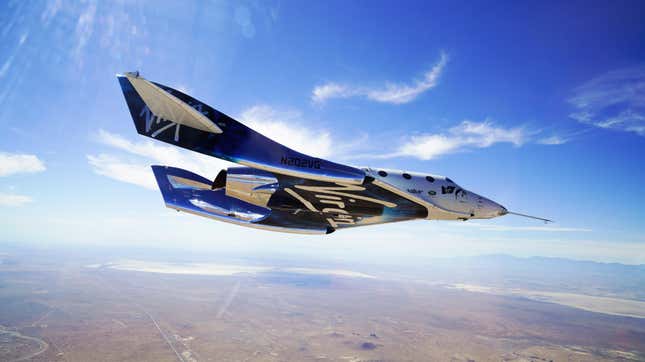
An upgraded FAA operators license now allows Virgin Galactic to include paying customers on its space flights, in what is a major milestone for the company and also the nascent space tourism sector.
The space tourism industry is starting to heat up.
Blue Origin will attempt its first crewed launch of the New Shepard rocket in July, with Amazon CEO Jeff Bezos and the winner of a $28 million auction on board for the ride. Bezos is poised to beat his rivals in the emerging cold war of billionaires trying to get to space before the other guy, but today’s news—that Virgin Galactic has secured an upgraded license to fly paying customers to space—means Richard Branson might actually be the first among them to see the curvature of Earth from suborbital space.
Virgin Galactic’s previous operators license, which dates back to 2016, authorized the company to include “non-deployed scientific, experimental, or inert payloads” on its flights. Paying customers were verboten, at least until Virgin Galactic was able to “verify the integrated performance of a vehicle’s hardware and any software in an operational flight environment,” according to FAA regulations. The verification process also needed to include flight testing, a requirement, along with others, that Virgin Galactic has successfully met.
In a statement, Virgin Galactic claims this is the first license to be issued by the FAA that allows a “spaceline to fly customers to space.” This comes as a surprise, given Blue Origin’s plans to do the same in July, so we reached out to them to inquire about their licensing status.
“We are progressing through our nominal timeline and established plan with the FAA, with expected timing aligned to our flight on July 20,” explained a Blue Origin spokesperson in an email.
That appears to be corporate-speak for not yet having FAA permission, but regardless, this is obviously a huge deal for Virgin Galactic, which kickstarted the project back in 2004, and the space tourism industry in general. News of the upgraded license saw the company’s share value jump by as much as 15%, as Bloomberg reported.
Virgin Galactic has had a painful journey to this achievement. In 2014, VSS Enterprise, a SpaceShipTwo test vehicle, crashed during a flight test, killing co-pilot Michael Alsbury and seriously injuring pilot Peter Siebold.
Virgin Galactic’s SpaceShipTwo flight system doesn’t work like conventional rockets, which launch vertically from the ground. Instead, a spaceplane is lifted to high altitudes by a four-engine carrier. Once at heights of around 8.1 miles (13.1 kilometers), the spaceplane releases from the carrier and fires its rocket engines, taking it and its passengers to altitudes slightly in excess of 60 miles (95 km). The spaceplane stays in suborbit for several minutes, after which time it glides back to the spaceport, where it lands on a runway.
During its most recent flight test on May 22, VSS Unity reached an altitude of 55.5 miles (89.3 km) and a maximum speed of Mach 3. The FAA recognizes the boundary of space at 50 miles (80 km) above Earth, which is good enough for Virgin Galactic. This falls below the Karman Line, which recognizes space as beginning 62 miles (100 km) above the surface. Some might quibble, therefore, that Virgin Galactic’s vehicles aren’t actually reaching space. You can read more on this contentious subject in a post I wrote back in 2018, “Historic Virgin Galactic flight reminds us that space is just a concept, man.”
Speaking of the May 22 test flight, it actually went exceptionally well, and it paved the way for the FAA upgrade. It was the company’s third crewed flight, and its first from Spaceport America in New Mexico. Recent upgrades to the system worked properly, and the flight was able to include revenue-generating research experiments for NASA.
The newly upgraded license and the successful test on May 22 “give us confidence as we proceed toward our first fully crewed test flight this summer,” Michael Colglazier, Virgin Galactic CEO, said in a statement.
The date of that test flight, and two other scheduled flights, have not been disclosed, but speculation is already emerging that Branson could take part in the first flight and that it’ll happen before Jeff Bezos climbs into his New Shepard rocket. Nothing is confirmed, so we’ll have to wait and see.